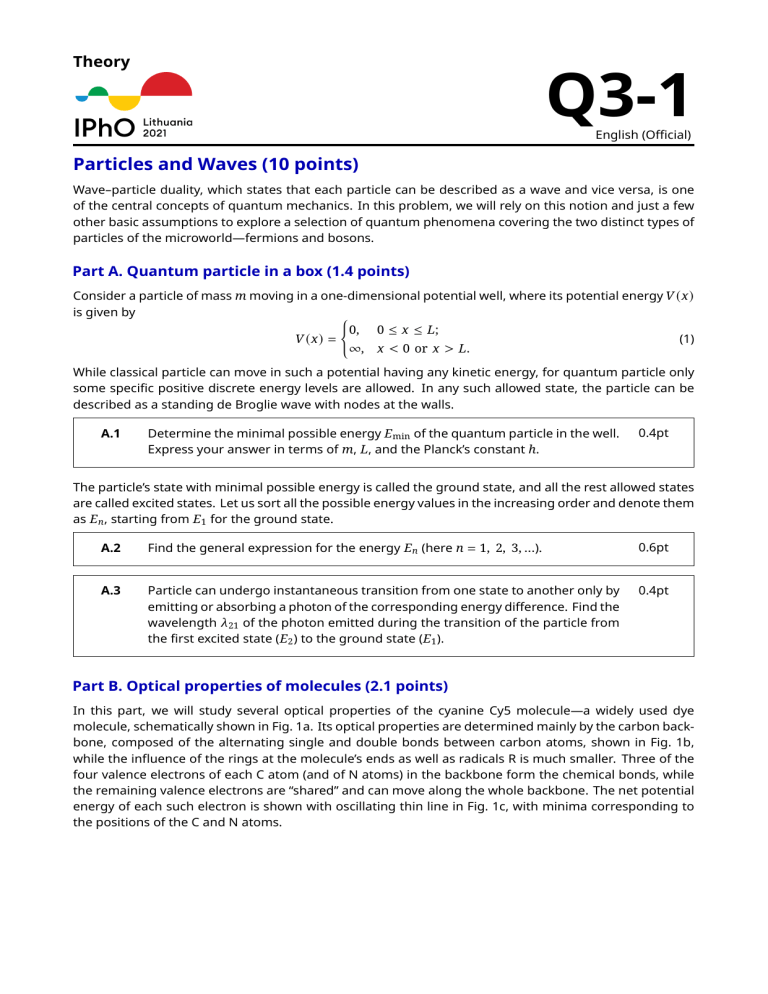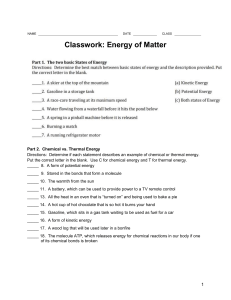
Theory
Q3-1
English (Official)
Particles and Waves (10 points)
Wave–particle duality, which states that each particle can be described as a wave and vice versa, is one
of the central concepts of quantum mechanics. In this problem, we will rely on this notion and just a few
other basic assumptions to explore a selection of quantum phenomena covering the two distinct types of
particles of the microworld—fermions and bosons.
Part A. Quantum particle in a box (1.4 points)
Consider a particle of mass 𝑚 moving in a one-dimensional potential well, where its potential energy 𝑉 (𝑥)
is given by
{
𝑉 (𝑥) =
0,
0 ≤ 𝑥 ≤ 𝐿;
(1)
∞, 𝑥 < 0 or 𝑥 > 𝐿.
While classical particle can move in such a potential having any kinetic energy, for quantum particle only
some specific positive discrete energy levels are allowed. In any such allowed state, the particle can be
described as a standing de Broglie wave with nodes at the walls.
A.1
Determine the minimal possible energy 𝐸min of the quantum particle in the well.
Express your answer in terms of 𝑚, 𝐿, and the Planck’s constant ℎ.
0.4pt
The particle’s state with minimal possible energy is called the ground state, and all the rest allowed states
are called excited states. Let us sort all the possible energy values in the increasing order and denote them
as 𝐸 𝑛 , starting from 𝐸1 for the ground state.
A.2
Find the general expression for the energy 𝐸 𝑛 (here 𝑛 = 1, 2, 3, ...).
0.6pt
A.3
Particle can undergo instantaneous transition from one state to another only by
emitting or absorbing a photon of the corresponding energy difference. Find the
wavelength 𝜆 21 of the photon emitted during the transition of the particle from
the first excited state (𝐸2 ) to the ground state (𝐸1 ).
0.4pt
Part B. Optical properties of molecules (2.1 points)
In this part, we will study several optical properties of the cyanine Cy5 molecule—a widely used dye
molecule, schematically shown in Fig. 1a. Its optical properties are determined mainly by the carbon backbone, composed of the alternating single and double bonds between carbon atoms, shown in Fig. 1b,
while the influence of the rings at the molecule’s ends as well as radicals R is much smaller. Three of the
four valence electrons of each C atom (and of N atoms) in the backbone form the chemical bonds, while
the remaining valence electrons are “shared” and can move along the whole backbone. The net potential
energy of each such electron is shown with oscillating thin line in Fig. 1c, with minima corresponding to
the positions of the C and N atoms.
Theory
Q3-2
English (Official)
Figure 1. (a) Chemical structure of the cyanine Cy5 molecule (for simplicity, hydrogen atoms
are not shown, and R denote some radicals). (b) The backbone of the Cy5 molecule, with mean
inter-atomic distance 𝑙 . (c) Potential energy of the electron along the backbone (thin line) and
its approximation by the step function given by Eq. 1 (thick line).
For simplicity, we will approximate this potential energy profile by a simple function given in Eq. 1 with
the width 𝐿 = 10.5𝑙 (see thick line in Fig. 1c), here 𝑙 = 140 pm is the mean inter-atomic distance (see also
Fig. 1b). As a result, we obtain the “electronic gas” composed of 10 electrons (7 from C atoms, 2 from the
N atom, and 1 from the N+ ion), moving in a one-dimensional potential well discussed in part A. In our
evaluation, we can neglect the mutual interaction of these electrons; however, we should account for the
fact that electrons are fermions and thus obey the Pauli exclusion principle. We also neglect the influence
of other electrons as well as motion of the nuclei.
B.1
Evaluate the largest wavelength 𝜆 of the photon that can be absorbed by the
Cy5 molecule assuming that the electron system is initially in its ground state.
Express your answer in terms of 𝑙 , physical constants and some numerical prefactor, and calculate the numerical value.
0.8pt
B.2
Another dye molecule Cy3 has similar structure, but its backbone is shorter by
2 carbon atoms. Is its absorption spectrum shifted to the bluer or to the redder
spectral region compared to the Cy5 molecule? Evaluate numerically the magnitude Δ𝜆 of this spectral shift. You can assume that removing two carbon atoms
doesn’t change the molecule shape and only makes the backbone length shorter
by two interatomic distances.
0.4pt
Being in the excited state, molecule can undergo a spontaneous transition to the ground state while emitting photon. The mean rate 𝐾 of such events (i.e. the relative decrease of the molecules being in the
excited state, d𝑁/𝑁 , over time d𝑡 , 𝐾 = 𝑁1 dd𝑁𝑡 ) is determined by the wavelength 𝜆 of the emitted photon,
the transition electrical dipole moment 𝑑 (which is of the order of 𝑑 ' 𝑒𝑙 , here 𝑒 is elementary charge) as
well as vacuum permittivity 𝜀0 and Planck’s constant ℎ.
B.3
Using dimension analysis, determine the expression for the rate of spontaneous
emission in terms of 𝜀0 , ℎ, 𝜆 , and 𝑑 . The numerical prefactor for your expression
is = 16
𝜋3 .
3
0.7pt
Theory
Q3-3
English (Official)
B.4
For Cy5 molecule, 𝑑 ≈ 2.4 𝑒𝑙 . Evaluate the mean fluorescence lifetime of the
lowest excited state of Cy5 molecule, 𝜏Cy5 , which is reciprocal to the rate of its
emissive transition to the ground state.
0.2pt
Part C. Bose-Einstein condensation (1.5 points)
This part is not directly related to Parts A and B. Here, we will study the collective behaviour of bosonic particles. Bosons do not respect the Pauli exclusion principle, and—at low temperatures or high densities—
experience a dramatic phenomenon known as the Bose–Einstein condensation (BEC). This is a phase transition to an intriguing collective quantum state: a large number of identical particles ‘condense’ into a
single quantum state and start behaving as a single wave. The transition is typically reached by cooling a
fixed number of particles below the critical temperature. In principle, it can also be induced by keeping
the temperature fixed and driving the particle density past its critical value.
We begin by exploring the relation between the temperature and the particle density at the transition. As
it turns out, estimates of their critical values can be deduced from a simple observation: Bose-Einstein condensation takes place when the de Broglie wavelength corresponding to the mean square speed of the particles
is equal to the characteristic distance between the particles in a gas.
C.1
Given a non-interacting gas of 87 Rb atoms in thermal equilibrium, write the expressions for their typical linear momentum 𝑝 and the typical de Broglie wavelength 𝜆 dB as a function of atom’s mass 𝑚, temperature 𝑇 and physical constants.
0.4pt
C.2
Calculate the typical distance between the particles in a gas, ℓ, as a function
of particle density 𝑛. Hence deduce the critical temperature 𝑇𝑐 as a function of
atom’s mass, their density and physical constants.
0.5pt
To realize BEC in the lab, the experimentalists have to cool gases to temperatures as low as 𝑇𝑐 = 100 nK.
C.3
What is the particle density of the Rb gas 𝑛𝑐 if the transition takes place at such
a temperature? For the sake of comparison, calculate also the ‘ordinary’ particle
density 𝑛0 of an ideal gas at the standard temperature and pressure (STP), i.e.
𝑇0 = 300 K and 𝑝0 = 105 Pa. How many times is the ‘ordinary’ gas denser? You
may assume that the mass of the atoms is equal to 87 atomic mass units (𝑚amu ).
0.6pt
Part D. Three-beam optical lattices (5 points)
The first Bose-Einstein condensates were produced back in 1995, and since then the experimental work
has branched out in diverse directions. In this part, you will investigate one particularly fruitful idea to load
the condensate into spatially periodic potentials created by interfering a number of coherent laser beams.
Due to the periodic nature of the resulting interference patterns, they are referred to as optical lattices.
The potential energy 𝑉 ( 𝑟®) of an atom moving in an optical lattice is proportional to the local intensity of
the light, and in your calculations you may assume that
⟨
⟩
® 𝑟®, 𝑡)| 2 .
𝑉 ( 𝑟®) = −𝛼 | 𝐸(
(2)
Here, 𝛼 is a positive constant, and the angle brackets indicate time-averaging which eliminates the rapidly
Theory
Q3-4
English (Official)
oscillating terms. The electric field produced by the i-th laser is described by
𝐸®𝑖 = 𝐸0,𝑖 𝜀®𝑖 cos ( 𝑘®𝑖 · 𝑟® − 𝜔𝑡),
(3)
with the amplitude 𝐸0,𝑖 , the wave vector 𝑘®𝑖 , and the unit-length polarization vector 𝜀®𝑖 .
Figure 2. (a) Three-beam optical lattice: three plane waves with wave vectors 𝑘®1,2,3 intersect
and interfere in the area indicated by the grey circle. (b) Symmetries of a regular hexagon:
solid and dashed lines show two sets of symmetry axes. (c) Saddle point: a point on a surface
where the slopes in orthogonal directions are all zero, but which is not a local extremum of
the plotted function. Travelling along the trajectory marked by the full line one encounters an
apparent minimum. Additional analysis of the perpendicular direction (dashed line) is needed
to distinguish a true minimum from a saddle point (shown).
Your task is to study triangular optical lattices that are produced by interfering three coherent laser beams
of equal intensity. A typical setup is shown in Fig. 2a. Here, all three beams are polarized in the 𝑧 direction,
propagate in the 𝑥 𝑦 plane and intersect at equal angles of 120°. Choose the direction of the 𝑥 axis parallel
to the wave vector 𝑘®1 .
D.1
Using Eqs. 2 and 3 obtain the expression for the potential energy 𝑉 ( 𝑟®) as a function of 𝑟® = (𝑥, 𝑦) in the plane of the beams.
Hint: the result can be neatly expressed as a constant term plus a sum of three
cosine functions of arguments 𝑏®𝑖 · 𝑟®. Please write your result in this form and
identify the vectors 𝑏®𝑖 .
1.4pt
D.2
The resulting potential energy has a sixfold rotational symmetry axis, i.e., the
potential distribution is invariant with respect to a rotation by a multiple of 60°
around the origin. Provide a simple argument to prove that this is indeed the
case.
0.5pt
The above observation of symmetry simplifies the analysis of the two-dimensional potential distribution
𝑉 ( 𝑟®) . As shown in Fig. 2b, a regular hexagon has symmetry lines that, respectively, connect opposite vertices (solid lines) and midpoints of opposite edges (dashed lines). Therefore, in our situation one does not
need to produce and study two-dimensional potential plots as many insights can be deduced by focusing
on the coordinate axes 𝑥 and 𝑦 that run along the symmetry lines.
Theory
Q3-5
English (Official)
D.3
Derive the behavior of the potential 𝑉 ( 𝑟®) along the coordinate axes, i.e., determine the functions 𝑉𝑋 (𝑥) ≡ 𝑉 (𝑥, 0) and 𝑉𝑌 ( 𝑦) ≡ 𝑉 ( 0, 𝑦) . Identify the locations
of the extrema of 𝑉𝑋 (𝑥) and 𝑉𝑌 ( 𝑦) as functions of a single argument. As these
functions are periodic, please include in your lists only one representative from
each family of periodically repeated minima and maxima.
1.2pt
We are interested in determining the locations of so-called lattice sites, i.e., the minima of the full twodimensional potential 𝑉 ( 𝑟®) . The obtained minima of single-argument functions 𝑉𝑋 and 𝑉𝑌 identify their
suspected positions but still have to be checked to eliminate the saddle points. As shown in Fig. 2c, when
studied along a single line, saddle points may disguise as minima but they are not.
D.4
Review your results in the previous question to determine actual minima of the
optical lattice: Identify all equivalent minima nearest to (but not coinciding with)
the origin. What is the distance 𝑎 between the nearest minima, in other words—
the lattice constant of our optical lattice? Express the answer in terms of the laser
wavelength 𝜆 las .
0.8pt
Charge neutrality of ultracold atoms suggests that their interactions become relevant only when two or
more atoms occupy the same site of an optical lattice. However, experimentalists are also able to explore
setups that sustain long-range atomic interactions. A possible approach relies on creation of the so-called
Rydberg atoms that are physically large and feature other exaggerated properties. Rydberg atoms are
excited atoms with one electron promoted to a state with a very high principal quantum number 𝑛. The
size of a Rydberg atom can be estimated by calculating the radius of the classical circular orbit of that
electron with the orbital angular momentum 𝑛ℏ, here ℏ is the reduced Planck constant.
D.5
Calculate the value of 𝑛 that corresponds to the radius of the Rb Rydberg atom
comparable to the wavelength of laser light 𝜆 las = 380 nm. Give your answer in
terms of 𝜆 las and physical constants and find its numerical value.
1.1pt







